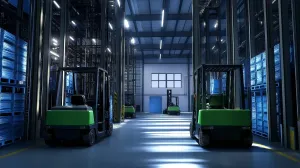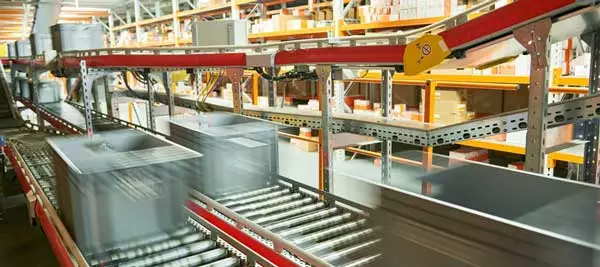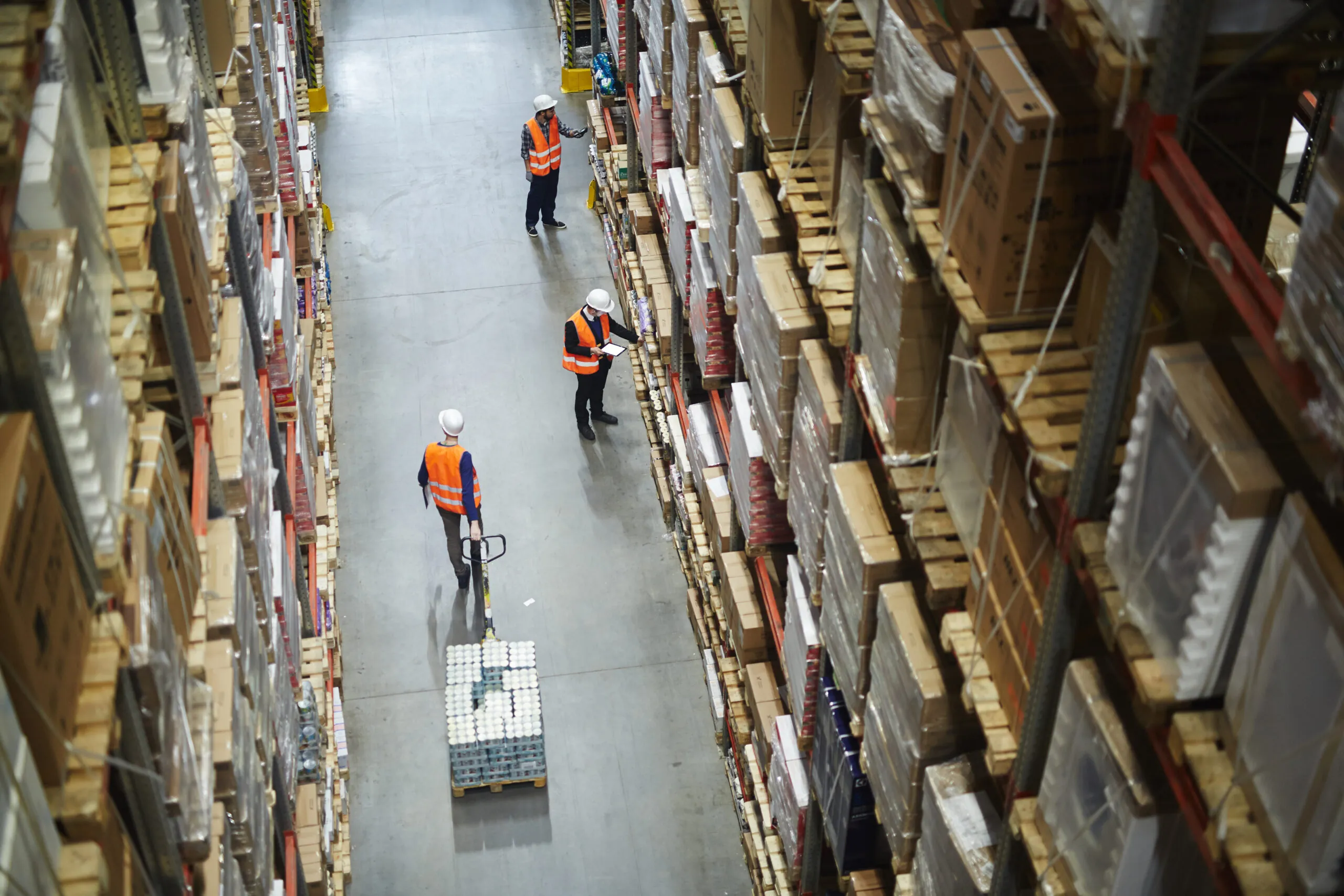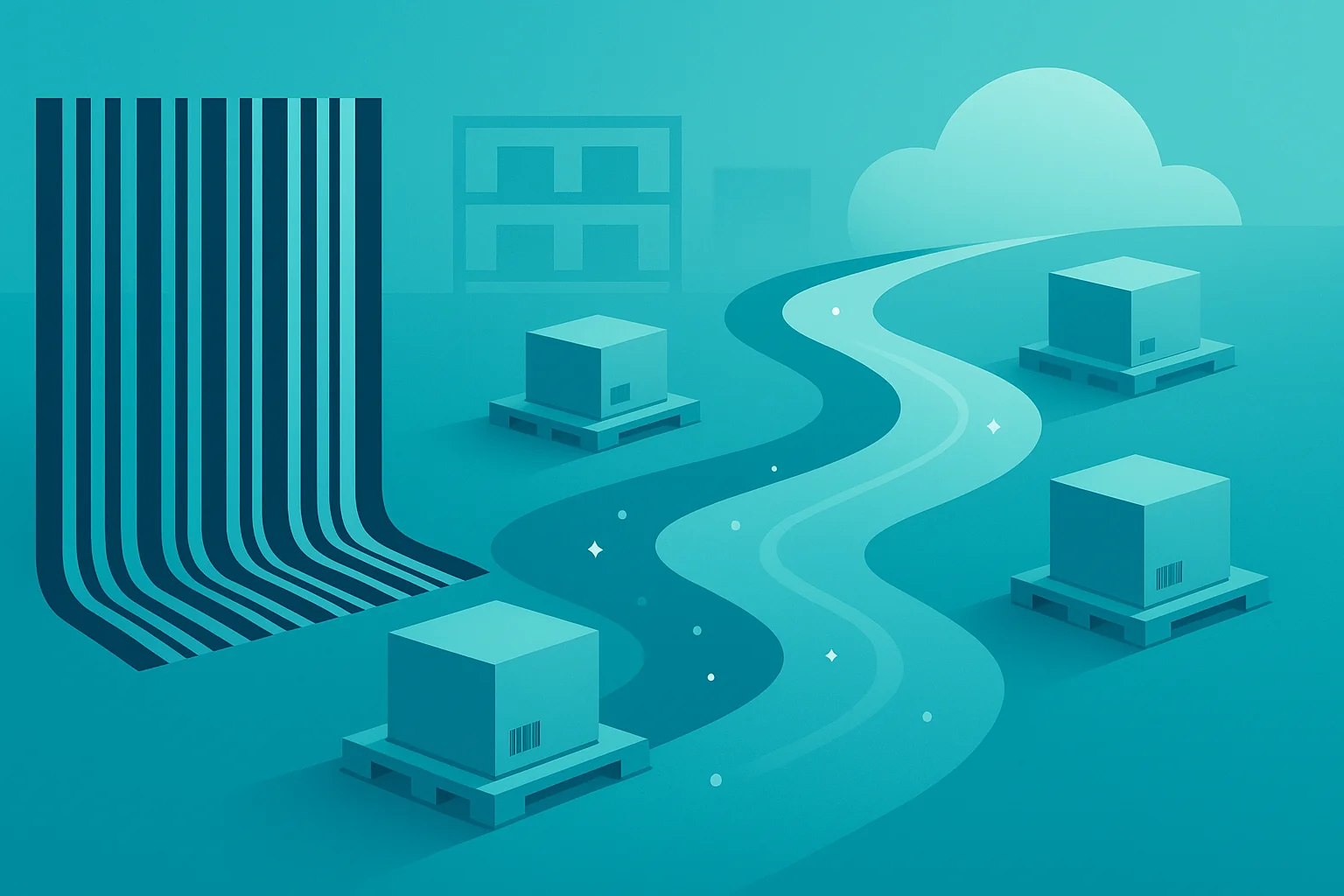
Warehousing 101: An Introduction to Digital Warehouse Automation
Key Takeaways:
- Warehousing and distribution face unprecedented pressures from COVID-19 disruption, commoditization, labor shortages and rising customer expectations.
- Warehouse automation is an effective way to gain efficiencies, cut costs and scale operations.
- Physical warehouse automation is costly. Digital warehouse automation software is low-cost, low-risk with short ROI.
- Instead of million-dollar investments, start with digital automation basics: data collection, inventory control and WMS lite.
- Look for an all-in-one warehouse automation solution that fits your business model.
Challenges of Warehouse Management
Supply chain professionals are facing more challenges than ever in the constantly changing world of warehouse management. COVID-19’s impact has resulted in significant disruption. Maturing trends in omnichannel retailing, consignment inventory, and complex global supply chains put more pressure on the warehouse to increase throughput, cut costs, and reduce inventory cycles.
Add to this the impact of external factors like the Amazon Effect, commoditization and customer expectations of next day and same-day shipping, and it’s clear that warehousing must find new ways to solve challenges more effectively.
Warehouse automation software could be the answer.
Warehouse Automation Software to the Rescue

As a warehouse professional, you also face the internal pressure of continuously managing the storage and handling of greater volumes of inventory, raw materials and assets more efficiently year-over-year. That means having to implement new improvement strategies to gain critical efficiencies, reduce costs, and maximize productivity.
You also have countless responsibilities to worry about as well, such as:
- Managing warehouse employees
- High warehouse turnover
- Driving higher KPI performance and goals
- Meeting new growth targets
- Upkeeping old equipment and technology
If all of this sounds like a lot, that’s because it is. Zebra listed all these factors and more as drivers of change in the warehouse marketplace. In short, your job is not only difficult but may be getting more difficult every year.
You’re not alone.
Warehouse Automation technology may be the key to solving your warehouse and distribution challenges—and making your life a little easier in the process. Thousands of businesses worldwide have already taken the leap. According to Westernacher Consulting, worldwide spending on warehouse automation technology has already topped $2 billion and is expected to reach $22.4 billion in market value by the close of 2021.
However, physical automation solutions like pick-to-light equipment can come with a hefty price tag. Many operations lack the available budget. Even if money is available, few can risk a failed implementation.
Fortunately, digital warehouse automation solutions (“software”) are inexpensive, like mobile barcoding and data collection. Any warehouse operation can benefit from digital automation.
Also Read: Avoid 7 Common Cost Leaks from Manual Processes »
What is Warehouse Automation?

In a nutshell, warehouse automation enables a warehouse operation to achieve greater outcomes with significantly less effort through the use of one or more technologies. The best warehouse automation solutions are scalable, ergonomic, and provide a return on investment (ROI) in months, not years.
Warehouse Automation comes in two parts: Digital Automation and Physical Automation.
Digital automation digitizes and automates manual processes, like inventory data collection. Data is automatically captured into your software environment, such as your database or Enterprise Resource Planning (ERP) system. Digital warehousing automation is also known as warehouse automation software, process automation, digital process automation, or system automation.
Warehouse automation software solutions like mobile barcoding are low-cost and beneficial to any inventory handling operation. Mobile barcoding runs on an ecosystem of barcode software and wireless barcode scanners to input and track data, which is then communicated via software to a centralized repository in real-time, where the information is stored for future retrieval.
LEARN MORE: How mobile data collection influences automation »
A survey conducted for Zebra’s Warehouse Vision Report found that 59% of IT and operations personnel in manufacturing, retail, transportation and wholesale market segments planned to expand process automation between 2017 and 2022.
Physical automation, which includes various forms of mechanized automation, refers to the use of robots and robotic systems in the warehouse. More costly to implement, physical automation only provides a reasonable ROI for larger high-volume warehouse and distribution center (DC) operations. Examples of physical automation include goods-to-person (GTP) technology, driverless automated guided vehicles (AGVs) and Autonomous Mobile Robots (AMRs), such as those manufactured by Fetch Robotics.
Both types of automation enable improvements in warehouse procedures to levels not possible by human agency alone. They “automate” by taking over repetitive and time-consuming or difficult tasks, freeing your warehouse personnel to concentrate on more meaningful activities where human intervention is required.
Modern warehouses typically use process automation in one form or another. Bigger warehousing and DC enterprises may also utilize physical automation as well.
While automation is powerful, not all types of automation carry equal impact or are necessarily the right answer for your specific needs. For example, if you’re a single-facility operation, you probably shouldn’t invest in an automated storage/retrieval system (AS/RS) like those used by Amazon—nor could your organization afford the $10 million price tag.
LEARN MORE: Preparing for automated warehouse robots »
More basic automation principles, however, can provide an ROI in 12-16 months, depending on your solution provider. That’s why investing in the right type of automation for your organization can make the difference between implementation success or failure.
If you need a high-value, high-impact solution and you’ve got the budget to make it happen, then introducing physical or sophisticated mechanical automation equipment into your warehouse workflows may be right the choice. However, due to the unique requirements and floorplans of individual warehouse or DC facilities, physical automation can also be difficult to scale across your operation.
Compare this to process automation in the form of an automatic data collection (AIDC) solution (“barcode software”). Mobile barcoding solutions, in particular, can be adopted and scaled across warehouse operations of virtually any size, type, location or industry.
Why You Should Automate Your Warehouse
The warehouse occupies a critical role in the supply chain. As a core component of logistics management, your warehouse is not just a back-end operation that stores goods, materials or assets. It’s a critical link fundamental to the success of the greater supply chain it’s connected to. Problems or delays in the warehouse operation can flow downstream to impact invoicing, cash flow and customer satisfaction.
CyberCore Technologies offers a great example of how the right solution and implementation plan can have a major impact on enterprise-wide operations.
Since inefficient processes can have downstream consequences, that means the reverse is also true. Using automation, efficiency gains created in the warehouse can be passed on, driving improvements in the rest of the organization and supply chain.
Over the decades, warehouse management has developed into an intricate science. Automation technology taps into this knowledge-base to position the warehouse to improve performance, catalyze faster turnaround in supply chain process cycles, and support company growth.
Some of the areas that warehouse automation that can improve operations include:
- Reducing operating expenses, overhead and unnecessary costs from errors
- Protecting the company’s assets, brand and reputation with customers and partners
- Increasing efficiency and productivity of human resources
- Minimizing manual processes and handling of stock-keeping units (SKU)
- Maximizing warehouse space utilization, layout and flow
- Coordinating usage of material handling equipment (MHE), such as barcode scanners and mobile computers
Companies that introduce automation technologies in their warehouse often experience several of the following benefits:
Lower Costs
Automation helps reduce overhead, driving cost savings associated with labor, equipment and maintenance, while also increasing throughput. It also pushes down spends for energy consumption, storage space and safety incidents.
Workforce Productivity & Retention
Automation can raise the productivity of each worker without increasing your headcount, in turn increasing the throughput of each shift. By making the jobs of your warehouse team easier and safer, you create a more attractive place to work—an important factor in today’s market.
Healthier Inventory
Automating processes, such as data collection and inventory transactions, can help reduce lost inventory, shrinkage and misplacement while also pushing toward 99.999% accuracy. This level of inventory control means fewer shipping errors as well. It also contributes to reducing or eliminating the need for staging to support just-in-time (JIT) methodologies for order fulfillment.
Click here to learn more about accelerating your inventory management practices.
Sustainable “Green” Practices
Automation reduces the amount of energy required to run your facilities, lowering costs, waste and land use, and minimizing your facility’s impact on the environment. These benefits become especially impactful for refrigerated or temperature-controlled facilities or warehouses that handle hazardous waste.
Now that we’ve talked about the “what” and “why” of warehouse automation, let’s dig into the “when” and “how.”
READ MORE: 5 Hidden Costs of Using Spreadsheets for Warehouse Inventory »
When to Introduce Automation
By now, you may be asking yourself: “This sounds great, but when do I bring automation into my warehouse?”
Essentially, warehouse automation is needed when the burden of handling warehouse processes manually (with paper, spreadsheets, tribal knowledge, etc.) has exceeded the needs of the organization. When this happens, you may experience one or more of the following symptoms:
- Your current processes are too labor- and time-intensive
- You struggle to get orders out on time
- Order fulfillment is inaccurate
- You’ve increased headcount to check and recheck order accuracy
- You can’t trust your inventory levels because counts are rarely right
- Your legacy solution requires too much upkeep
- Your customers are unhappy, no matter what you do
Sound familiar? It may be time to automate your warehouse.
The good news is that you’re not the only supply chain professional left scratching your head. Thousands of warehouse managers and IT professionals have solved these very same problems by implementing warehouse automation solutions.
You can do the same.
How to Automate Your Warehouse
Warehouse automation is a “crawl-walk-run” process. Before jumping into AS/RS systems and autonomous robots, you need to start with the basics and then build on those fundamentals.
Let’s start with the first steps of your warehouse automation journey:
1. Start with Data Collection

The very first area of your warehouse to automate should be the data collection process.
Traditionally, data is collected is through handwritten notes on paper or manually keyed or re-keyed data entry. This data is then stored either digitally on a spreadsheet or a database (such as an AS/400 database), or physically in a folder or convenient location in the warehouse, or not at all. As of 2016, nearly 60% of warehouses still use physical processes in their inventory control workflow.
Where data collection accuracy starts, however, is in receiving.
When a shipment of product arrives in receiving, your employee—let’s call him “Receiving Joe”—inspects each box or item on the pallet, writes down or types in the SKUs and quantities, before being stored in bins. Each time Receiving Joe manually enters an SKU number, quantity, or any other type of information, there’s a possibility of human error, such as a transposition of two numbers. That error then compounds as the imperfectly captured data for that material is binned, transferred, picked, packed and then shipped.
In this scenario, the customer could potentially end up with the wrong product altogether because the transposed SKU represents a different item, setting off the costly return process. If the customer is particularly dissatisfied, they may share that opinion with others, dinging your company’s (or your partner company’s) reputation for delivering poor customer service.
Yikes. All because Receiving Joe transposed two numbers by mistake.
Now, let’s assume Receiving Joe processes 4,000 units of product each day. Even at 99.5% accuracy, this very small margin of error results in 20 imperfect transactions per workday. After a year (250 workdays), that 0.5% gap generates 5,000 bad inventory entries. It’s not Receiving Joe’s fault necessarily, just a natural consequence of performing repetitive tasks by hand.
Let’s assume Joe works on a receiving team with two other people of comparable productivity. Now those 20 bad transactions balloon into 15,000 per year. Multiply this 15,000 across three locations and now their enterprise is putting 45,000 incorrectly-identified items into stock annually, all of which is in danger of becoming lost, double-sold, or obsolete because that inventory can’t be located afterward due to bad data.
Needless to say, that 0.5% inaccuracy can have a huge impact on your operation. In more traditional operations, such as retailers that perform receiving, cycle counting and inventory validation by hand, inventory accuracy can be as low as 60% with a negative downstream impact to the rest of the business.
By automating the data collection process, we remove that opportunity for human error, thus reducing the chance that the product will be improperly received, stored, transferred, picked, packed, or shipped to the customer. Data collection automation involves implementing a system where information from incoming shipments are captured via a barcode scanner and communicated via software to central data repositories, such as a database or ERP system.
Because this capture process bypasses manual recording, captured data becomes cleaner and significantly more accurate—even up to 100%.
Modern automated data collection solutions take the capture process a step further by mobilizing the data capture devices in the form of wireless barcode scanners, handheld computers or ruggedized tablets. A truly automated mobile data collection solution will use device-agnostic software to enable two-way communication between those mobile handhelds and the database or ERP. Data can also be collected from all sources, such as barcodes, RFID tags, industrial internet of things (IIoT) devices, physical automation equipment (carousels, vertical lifts, etc.), and more.
Not only does this data collection ecosystem all but eliminate human error from the data entry process, it provides the warehouse manager with accurate, high-quality data that inform real-time decision-making regarding inventory stock levels and manufacturing materials or components.
By simply automating this one process, the entire warehouse, DC and/or manufacturing operation can operate at a level of efficiency not otherwise possible—with positive trickle-down effects to operations further downstream.
Don’t make the common mistake of neglecting data collection automation or waiting until you’ve already implemented other forms of automation, such as a WMS. Automated mobile data collection should be the first step in your warehouse automation journey. A survey conducted by Zebra indicated that 90% of warehousing professionals planned to use mobile handheld devices with real-time access to their inventory data by 2020, meaning organizations not already implementing enterprise mobility risk being left behind.
Mobile warehouse barcoding is an ideal solution for businesses just beginning their automation journey. Mobile barcoding in the warehouse includes:
- Mobile data collection to automate data captured with barcode scanners
- Enterprise mobility that extends ERP to enterprise and consumer mobile devices
- Flexibility and extensibility to start small and expand automation as needed
With mobile barcoding technology, warehouse and distribution companies have the option to start by automating only a few key processes. Then, as benefits are realized, you can expand digital automation into new areas, accelerating cost savings and performance gains.
2. Gain Control of Your Inventory

Inventory data is only as good as the quality of data you collect. So now that you’ve ensured your data will be collected with maximum quality and accuracy through automation, it’s time to put that data to use in inventory control.
Automating inventory control usually takes the form of an inventory management system (IMS). This software platform provides the ability to gain total visibility into your inventory as it flows through your warehouse. Although there are many IMS solutions out there, software like ShipStation is more tailored to smaller retail and online businesses while enterprise platforms, such as RFgen, are developed specifically with the needs of larger or enterprise companies in mind.
Inventory management software essentially allows the product data captured in receiving to be updated in real-time as inventory transactions take place. For example, Receiving Joe scans the products in receiving, automatically populating the IMS with data. Then, he hands the pallet off to Putaway Mary, who scans the bin where the stock will be stored. Now the system knows where to find the inventory and how much is on-hand in those particular bins. Later, the inventory can be transferred to a new bin with another set of scans.
When it comes time to pull that inventory for an order, Picker Larry has an exact count of that stock. Picker Larry picks the items and quantity and updates the IMS with his handheld scanner. Again, these transactions update the system in real-time. Packer Jane has the right product in the right amount, which is then sent to the customer. Now, the Warehouse Manager can see that the newly pulled items have caused the level of that stock to fall below the re-order threshold. Because the manager has accurate counts, (s)he doesn’t have to guess or take chances, let alone risk an inconvenient stockout.
IMS software offers numerous additional benefits for daily warehouse work:
- Drastically higher inventory accuracy
- Store less inventory on-hand, reducing overhead costs
- Inventory visibility to maintain optimum stock levels
- Faster pick, pack, ship and fulfillment
- Automated cycle counts that take hours, not weeks
- Part or food traceability to meet government regulations
- Easily issue inventory, parts or materials
Inventory software can also be expanded or customized to gain additional functionality:
- Capture or track data from other members of the supply chain, such as Global Trade Item Numbers (GTIN) and Country of Origin (COO).
- Add Advanced Shipping Notification (ASN) from a supplier or forwarder so your teams know the exact quantities of items to expect.
- Store and transfer received the product without creating unexpected traffic jams or blockages.
- Add License Plating to enable “inventory grouping” to intelligently manage groups of items as a single unit, facilitating receiving, putaway and transfers, or process manufacturing.
- Integrate with barcode label software to print new or custom barcodes on-demand from mobile devices.
- Add field mobility to extend inventory management into field services for field inventory, consignment inventory, remote warehousing and proof of delivery (DSD).
READ MORE about remote warehouse management »
Inventory control software should be paired with an automated data collection process, otherwise, your inventory levels will become inaccurate, creating the same problems as before. For example, Picker Larry may go to the bin only to find that the “on-hand” items he needed had already been shipped in a previous order. On the adjacent shelf, he notices a bin full of dusty microchips that have since become obsolete and worthless. When he checks the IMS, he discovers the bin isn’t even listed in the system. In both cases, money is lost due to bad or missing data.
Just as with Receiving Joe’s experience, bad or missing inventory data can be costly.
Ideally, your data collection solution will go hand-in-hand with your inventory management solution. Supply chain solutions providers like RFgen offer an all-in-one solution that helps you automate data collection, procure enterprise mobility hardware and integrate those systems with inventory management software and your database or ERP environment to create a multi-directional data communication ecosystem.
However, if you are looking to take warehouse process automation a step further to gain additional functionality and efficiency, you may be in the market for a warehouse management system, a WMS.
3. Implement a Warehouse Management System (WMS)

What is WMS? A warehouse management system, or WMS, is a software platform that takes over and automates internal warehouse logistics to make intelligent, real-time decisions that direct your worker movements through the warehouse with maximum efficiency. Research from the ARC Advisory Group indicates that WMS solutions can “provide the single best solution for reducing the cost associated with distribution while simultaneously improving service.”
Like inventory management software, a WMS helps you control and track the movement of materials in your warehouse or distribution center, but with far more functionality and operational flexibility. Unlike inventory control applications, true WMS software provides a higher level of control and resource utilization for product movement and storage in and around your warehouse and DC facilities.
Also Read: Gain best of breed WMS benefits at a fraction of the cost »
The first WMS were computer applications that provided simple storage and location functions. Since the early days of WMS, these programs have evolved significantly into either standalone applications or as an extension of your Enterprise Resource Planning (ERP) system that communicates with your database and other warehouse technologies, such as mobile devices, RFID tags and robotics.
The modern WMS has evolved out of the realization that warehouse employees spend a significant chunk of their time walking around. Picker Larry may spend 60% or more of his time trying to locate items—and that’s just one task. Your warehouse team also wastes time commuting to-and-from locations during receiving, putaway, restocking/replenishing, and while loading trucks and fulfilling orders.
Add to this daily maintenance tasks, such as trying to find room for incoming products, shifting stock around, and cleaning or reorganizing, and it becomes clear how many opportunities there are to lose out on productivity due to poor warehouse organization.
Warehouse management software streamlines these time-consuming tasks by directing processes like picking, putaway and replenishment along optimized paths that cut out unnecessary movement and minimize the time it takes to perform each action. Combined with the ability to direct and validate inventory transactions as it flows through the warehouse, WMS solutions have the potential to provide major gains in efficiency, productivity and cost-cutting.
Warehouse management software usually comes in two forms: as a standalone solution or an ERP module, such as the Advanced Warehouse Management module for JD Edwards or SAP’s Extended Warehouse Management product (SAP EWM). While expanding your existing ERP may sound attractive, note that these modules tend to be heavyweight solutions best-fitted for very large enterprise operations that generate hundreds of millions—if not billions—in revenue each year. These ERP module WMS systems tend to be highly complex, expensive, and resource-intensive to upkeep. In addition to paying for components, licensing and setup, your company will have to shell out money for development time and wages for IT support staff as well.
For the majority of companies, a WMS “Light” alternative may be more ideal. WMS “Light” solutions offer much of the core functionality of a full WMS but without the complexity, expense or upkeep. Products like the RFgen Warehouse Director can be deployed rapidly without intruding on existing infrastructure and offers an ROI in months instead of years. For example, Myers Tire Supply achieved significant end-to-end operational improvements using RFgen.
Regardless of your choice, it’s important to also have a thorough project plan in place before moving forward. Implementing a WMS can be complex and requires close integration with your existing warehouse processes and workflows. Your warehouse also needs to remain up and running at full speed while the new WMS is tested, integrated and deployed until your team has had a chance to learn the new system. Like any form of change management, an effective plan can make the difference between implementation success or failure.
In Conclusion
Warehouse automation can help you and your enterprise increase customer satisfaction to levels not otherwise possible through human-directed work alone. Automation is not only the future of warehousing but the badge of the modern warehouse, DC and manufacturing operation.
Warehouse automation comes in many forms, shapes and sizes. The important thing is to select the right types of automation for your company’s individual needs. While that doesn’t necessarily have to include physical automation with robots and automated material handling equipment, such as conveyors, sortations or storage equipment like carousels and AS/RS solutions, every warehouse can gain operational agility, flexibility and performance from some level of process automation.
To review:
- Automated mobile data collection enables your workforce to increase inventory data accuracy and productivity by eliminating manual capture processes.
- Inventory management software adds the next layer of automation by providing elevated inventory control and real-time visibility and into stock levels, storage locations and product information.
- Warehouse management systems (WMS) further optimizes and accelerates key warehousing tasks by directing receiving, putaway, picking, packing, shipping and space utilization along optimized routes.
Warehouse automation can:
- Improve efficiency, productivity and accuracy
- Increase visibility, control and operational agility
- Raise job satisfaction for your workforce
- Cut costs, reduce overhead and safety stock
- Drive higher customer satisfaction
- Generate downstream benefits for enterprise and supply chain
The list goes on.
If your company is expanding but experiencing growing pains in the supply chain, then warehouse automation may be on the horizon.
If you are interested in learning more about principles of warehouse automation, feel free to explore the Mobile Supply Chain blog, reach out to an expert, or download the following resource:

Key ROI Criteria for Warehouse Automation
How to Know When Warehouse Automation is Worth It.







